Jacks are designed to lift your vehicle, making it easier to change a tire or perform repairs underneath. Choosing a floor jack that can handle your vehicle’s weight prevents overloading and potential jack failures. Understanding weight ratings, jack types, and features helps you select the right jack for your needs. Here are tips on picking the right weight capacity jack for your vehicle:
Know Your Vehicle’s Weight
The manufacturer’s gross vehicle weight rating (GVWR) is the maximum weight your vehicle jack can handle when fully loaded. For semi-tractor trailers, an attached trailer’s gross vehicle weight rating must also be factored in when determining total weight. Add the loaded weights of the tractor and trailer together to get the overall weight you need to lift. Things like toolboxes, sideboards, tanks, and generators can add hundreds of pounds. Take an inventory of everything attached to your vehicle that may increase the lifting requirements beyond factory specs when selecting jack weight capacity. Understanding your vehicle’s weight capacity and specifications can help you acquire a jack that can fit your vehicle’s weight.
Allow for a Safety Buffer
A jack’s weight rating is its absolute maximum capacity, but it is best not to load it right up to that threshold. Leaving a small buffer under the weight rating may help enhance safe lifting. A jack rated for moderately more than your actual vehicle weight provides this safety buffer zone.
Decide One End or All Wheels
Standard jacks are designed to lift one end of a vehicle at a time, not all four wheels at once. Only one end of the total vehicle weight needs to be supported by the standard jack while lifting as opposed to all wheels. For a semi-tractor trailer, lifting just the front of the tractor or the rear tandem axles requires less weight capacity than the whole rig. Basing jack capacity on lifting all corners together may require strong material or multiple floor jacks.
Choose Quality Components
Sturdy steel frames, reinforced lift arms, and rugged fasteners boost a jack’s weight-lifting abilities. Heavier steel materials withstand years of use without bending, cracking, or leaking fluid. Premium hydraulic cylinders and sealed pumps enable smooth lifting under heavy loads without buckling. Strong bearings and pressed-steel wheels add rollability to your floor jack. Look for jacks made with heavy-gauge steel for the lift arm, chassis, and pump cylinder.
Select the Right Jack Saddle and Pads
Choose a saddle design that fits your vehicle lift points to prevent slipping and damage. Rubber saddles conform to surfaces. Notched wide saddles can securely grasp frame rails. Round saddles work on axles. Confirm your jack’s saddle suits the jacking points on your vehicle.
A floor jack lift pad with a large surface area helps distribute weight to avoid pressure points. Small pads concentrate force and can damage frame components. Matching the lift pad width to factory jacking points or outriggers on trailers safely spreads the pressure exerted by the vehicle, avoiding any damage and injury.
Check the Max Lift Height
Confirm that a jack’s maximum lift height exceeds the underside clearance of your vehicle. Trucks and SUVs with high ground clearance require more extension to contact the chassis. Choose a floor jack engineered to your vehicle’s height to allow full lifting. Ascertain that the jack can maintain its full weight capacity even at maximum height to prevent any risk of instability.
Inspect Before Each Use
High-quality jacks may require pre-use checks to avoid failure under load. Before lifting, look for cracked welds, bent frames, loose bolts, or low hydraulic fluid. Test the jack’s operation before it’s loaded to determine if it will rise and hold position.
Invest in the Right Floor Jack Today
Matching your vehicle’s weight to a jack protects both your investment and safety. A floor jack made with high-quality materials is long-lasting and ready to use in the case of unexpected repairs. Buy a heavy-duty jack that aligns with your vehicle’s weight capacity today.
